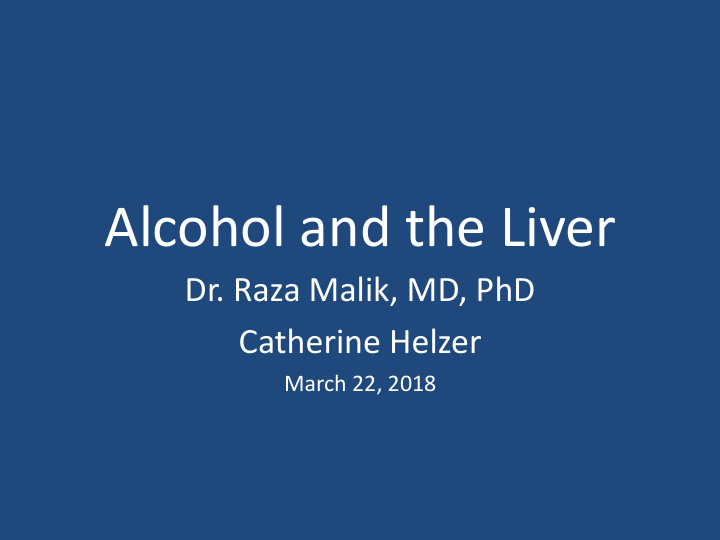



Alcohol and the Liver Dr. Raza Malik, MD, PhD Catherine Helzer March 22, 2018
Alcohol and the Healthy Liver • The liver is the largest solid organ in the body (about 3 – 4 pounds) • One of the liver’s jobs is to break down alcohol • Alcohol enters the blood stream through the stomach and upper intestine (higher alcohol concentration means it will be absorbed quicker) • Alcohol is then carried to the liver as well as other organs and body tissues • The liver cannot store alcohol, can only process about one drink per hour
Alcohol Intake • Moderate Alcohol Consumption – Women: ≤ 1 drinks/day – Men: ≤ 2 drinks/day • Low Risk for Alcohol Use Disorder – Women: ≤ 3 drinks/day and ≤ 7 drinks/week – Men: ≤ 4 drinks/day and ≤ 14 drinks/week • Binge Drinking – Women: ≥ 4 drinks in 2 hours – Men: ≥ 5 drinks in 2 hours • Heavy Alcohol Use – Women & Men: Binge drinking on ≥ 5 days/month
Rising Numbers in United States • Alcohol Abuse is rising • In 2013, 139,000 deaths globally due to alcohol abuse • In 2013, 384,000 additional deaths due to cirrhosis from excess alcohol consumption
Alcohol Abuse Impacts on the Body • (picture of person with each part of the body Brain Long term heavy alcohol abuse can speed brain cell loss and cause highlighted that is impacted by alcohol abuse impaired brain and nerve function. The brain often develops abnormal structures, such as deep, wide grooves. Esophagus Cancer of the esophagus is one possible outcome of long-term alcohol abuse. Alcohol is toxic to the cells lining the esophagus, making cancer more likely. Heart Massive doses of alcohol can lead to high blood pressure and scar tissue formation in the heart muscle. Fat inflammation can cause the heart to become nearly twice its normal size, which may lead to death from heart failure. Liver The liver is the main organ responsible for metabolizing alcohol A. Heavy drinking causes the liver to become fatty and enlarged, leading to liver dysfunction. B. Cirrhosis or scarring eventually appears, which can lead to liver failure and death. Stomach and Pancreas Alcohol is toxic to stomach cells and can lead to inflammation of the stomach (gastritis) with pain and bleeding. Alcohol abuse can also lead to inflammation of the pancreas, which can progress to pancreatic failure even death. Ascites Fluid produced by the diseased liver may fill the abdomen.
Physical Impact of Alcohol Abuse • Liver – Steatosis – Fatty liver disease – Alcoholic Hepatitis – Fibrosis – Cirrhosis • Heart – Cardiomyopathy – Stretching of heart muscles – Arrhythmias – Irregular heart beat – High Blood Pressure – Stroke
Physical Impact of Alcohol Abuse • Cancer – Mouth – Esophagus – Throat – Liver – Colon and rectum – Breast • Immune System – Weakened immune system – More likely to contract pneumonia and tuberculosis
Psychological Impact of Alcohol Abuse • Difficulty concentrating • Lowered inhibitions • Memory trouble • Impaired vision, coordination, and reflexes • Depression and anxiety • Tolerance as the body becomes accustomed to higher doses • Dependence on alcohol (alcoholism) • Learning and memory problems • Disruption of normal brain development
Social Impact of Alcohol Abuse • Failure to fulfill major role obligations at work, school, or home • Drinking in hazardous situations • Recurrent alcohol – related legal problems • Continued drinking despite persistent or recurrent social or interpersonal problems
Liver Cirrhosis • Scarring of the liver – hard scar tissue replaces soft, healthy tissue • As cirrhosis becomes worse, the liver may fail and will not be able to work well, or at all • Drinking too much alcohol can cause the liver to swell, leading to cirrhosis
Treatment • Prevention through early education • The goal of treatment is to prevent further liver damage and reduce complications: – Abstinence or drinking in moderation – Strong social network and family support – Intervention programs • Acute and End Stage Liver Disease – Experimental drugs/devices – Transplantation
Extracorporeal Liver Assist Device (ELAD) • Investigational device • Human cell-based liver support system designed to supplement hepatic function in order to improve survival rates among subjects with liver failure
Transplant • When cirrhosis cannot be treated, the liver will not be able to work and a liver transplant may be needed • Patients may wait on list for months or even years • Organ allocation is determined by blood type, body size, and severity of illness
References • http://www.drinkingandyou.com/site/us/health/liver.htm • https://www.niaaa.nih.gov/alcohol-health/overview-alcohol-consumption/moderate-binge- drinking https://www.npr.org/sections/thetwo-way/2017/08/10/542409957/drinking-on-the-rise-in-u-s- • especially-for-women-minorities-older-adults https://www.niaaa.nih.gov/alcohol-health/alcohols-effects-body • https://www.mayoclinic.org/diseases-conditions/alcoholic-hepatitis/symptoms-causes/syc- • 20351388 • http://loveyourliver.com.au/alcohol/ • http://www.heart.org/HEARTORG/HealthyLiving/HealthyEating/Nutrition/Alcohol-and-Heart- Health_UCM_305173_Article.jsp#.Wq_ui8PwaCg https://www.cancer.org/cancer/cancer-causes/diet-physical-activity/alcohol-use-and-cancer.html • https://americanaddictioncenters.org/alcoholism-treatment/physical-health/ • https://www.healthyplace.com/addictions/alcoholism/psychological-effects-of-alcohol/ • https://recoverycentersofamerica.com/news/psychological-effects-alcohol-abuse/ • https://pubs.niaaa.nih.gov/publications/arh27-1/52-62.htm • https://www.liverfoundation.org/for-patients/about-the-liver/diseases-of-the- • liver/cirrhosis/#frequently-asked-questions • http://vitaltherapies.com/liver-disease/alcohol-induced-liver-decompensation/ • http://vitaltherapies.com/elad/technology/
Recommend
More recommend